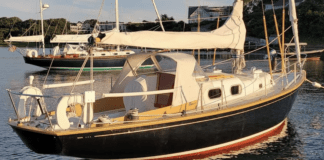
]Harken may be the most innovative. Frederickson may be more elegant. Garhauer may be the most robust. And Lewmar and Ronstan may be quicker to take advantage of composite materials. But Schaefer Marine has a sound blend of all such qualities—and it shows in this Massachussetts-based company’s recently introduced “Universal Deck Mount.”
The most interesting facet of this new product is the basic deck fitting, which is a low-profile, stainless steel casting. It requires in the deck a 1-3/4″ (45 mm) hole, which must be clear of any obstructions underneath (to permit the installation of the 1/8″-thick backing plate). The fitting should be, of course, positioned only where it can withstand the loads that may be applied.
After proper bedding, the fitting is intended to be secured with four 5/16″ machine screws, flat or oval head, which are not supplied because their length will be determined by the particular deck thickness where they’re mounted.
The deck fitting is a somewhat complicated casting. The receptacle hole is threaded at the bottom; the upper portion of the hole has a four-dog twist lock.
Once in place, this deck fitting accepts the following:
1. A sturdy cleat (with a four-dog base), can be mounted quickly and easily by placing it in the hole, matching up the dogs and, after lifting two small levers that raise two spring-loaded detent pins, applying a quarter turn, which locks it in place and engages the pins.
2. A Schaefer Series 8 stand-up block that mounts in the threaded portion of the deck fitting. (An O-ring serves as a washer.)
3. A deck eye (a.k.a. screw eye) that threads into place. It has an O-ring, as well.
If the deck plate is to be left idle, a threaded nylon plug (furnished, but you might want to buy a some spares) will protect the threads in the cavity. Despite the nylon plug, one suspects that the fitting’s cavity will need to be cleaned occasionally to avoid damage.
With such versatility, this new Schaefer innovation makes it possible to strategically place two, four, six or more such fittings on deck and use them, singly or in pairs, for a dozen or more purposes. Doing so would mean less mounted gear on deck, which diminishes the threat to toes and reduces the risk of snagging flapping lines, as well as reducing weight.
All of the parts that comprise Schaefer’s Universal Deck Mount are available individually. Though they’re not yet in the marine discount catalogs, the parts carry the following manufacturer’s suggested list prices:

Deck plate … $76
Cleat … $115
Screw eye … $20
Standup block … $142
When offered through West Marine or Defender, as the components no doubt will be, a full set will retail for roughly $275. That’s not cheap, but it’s typical rugged gear, well-designed and intelligently manufactured by a company widely known for furling gear and deck hardware (track, shackles, blocks, cleats, etc.).
We checked around and the only similar products we could locate are from Harken Yacht Equipment and Antal Marine Equipment. Both Harken’s custom Removable Padeye Base and Antal’s Screwed Eyebolt can have either a padeye or a standup block screwed into them. The base from Harken is novel in that the padeye is designed to swivel so that it lines up with the greatest load. Both are similar to Schaefer’s Universal Deck Mount, but neither company has yet fashioned their product to accept a cleat.
It’s important to note that both Harken and Antal have resolved the problem of moisture or dirt collecting in the threaded recess in their bases by way of permanent nylon inserts that screw further into the threaded recess when whichever fixture is screwed in above them, but also back out to be nearly flush with the top of the base when that item is removed. This is a clever solution that isn’t present on the Schaefer product, but the Universal Deck Mount still rules this domain due to its inclusion of a cleat.
Contact – Schaefer Marine, 508/995-9511, www.schaefermarine.com.







































